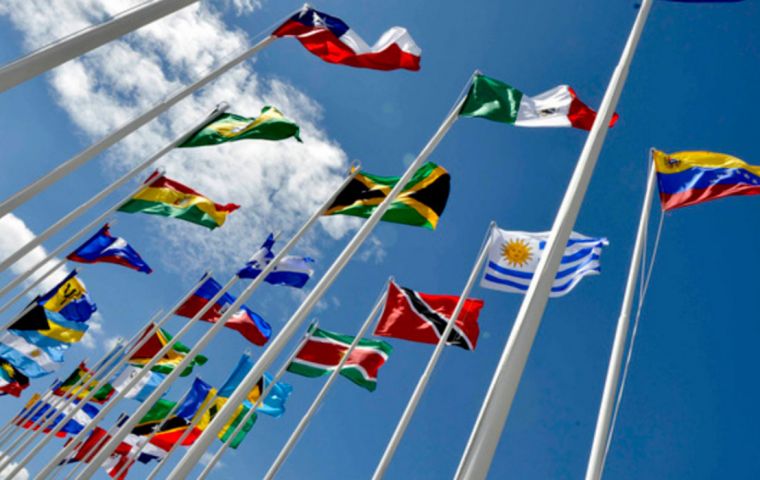MercoPress. South Atlantic News Agency
ECLAC foresees growth rate in 2022 around one third of that of 2021
 ECLAC recommended consolidating the income tax on individuals and corporations, extending the scope of taxes on heritage and property, while adding new taxes on the digital economy.
ECLAC recommended consolidating the income tax on individuals and corporations, extending the scope of taxes on heritage and property, while adding new taxes on the digital economy. Growth in Latin America and the Caribbean will slow down in 2022 to 2.1%, after a 6.2% increase on average last year, the Economic Commission for Latin America and the Caribbean (ECLAC) forecast Wednesday in a study.
The new projections, whereby combined progress this year will near on average one third of the figured recorded in 2021, comes amid structural problems of low investment and productivity, poverty and inequality, which require growth to be a central element of public policies, the report said.
ECLAC's annual report Preliminary Balance of the Economies of Latin America and the Caribbean 2021, released Wednesday in Mexico City also highlighted significant asymmetries between developed, emerging and developing countries on the ability to implement fiscal, social, monetary, health and vaccination policies for a sustainable recovery from the crisis unleashed by the COVID-19 pandemic.
“The expected slowdown in the region in 2022, together with the structural problems of low investment and productivity, poverty and inequality, require that strengthening growth be a central element of policies, while addressing inflationary pressures and macro-financial risks,” ECLAC's executive secretary Alicia Bárcena said during the virtual launching of the document.
According to the report, the region faces a very complex 2022: persistence and uncertainty about the evolution of the pandemic, a sharp slowdown in growth, low investment, productivity and slow recovery of employment remain, persistence of the social effects caused by the crisis, less fiscal space, increases in inflationary pressures and financial imbalances.
The expected average growth of 2.1% thus reflects high heterogeneity between countries and subregions: The Caribbean will grow 6.1% (excluding Guyana), Central America will grow 4.5%, while South America will grow 1.4%. Meanwhile, in 2021 the region showed higher than expected growth, averaging 6.2%, thanks to a poor overall performance in 2020 which resulted in a favorable comparison ground.
According to the Preliminary Balance Sheet 2021, estimates show that advanced economies would grow 4.2% in 2022 and would be the only ones to return this year to the growth path forecast before the pandemic.
Emerging economies, for their part, would have a growth of 5.1% in 2022 but would only return to a prepandemic growth level by 2025. In 2021, 11 countries in Latin America and the Caribbean managed to recover their GDP levels from before the crisis. In 2022 another three would be added, bringing a total of 14 countries out of the 33 that make up the region, the report said.
ECLAC also underlined the importance of combining monetary and fiscal policies to prioritize growth stimuli while containing inflation. This requires the use of coordinated macroeconomic policies and the use of all available instruments, to adequately prioritize the challenges of growth with monetary-financial stability.
Regarding employment, 30% of the jobs lost in 2020 had not yet been recovered by the end of 2021, while inequality between men and women was accentuated, the study said. For 2022, ECLAC projects an unemployment rate of 11.5% for women -slightly lower than the 11.8% recorded in 2021, but still much higher than the 9.5% existing before the pandemic in 2019-, while unemployment for men would stand at 8.0% this year, almost the same as in 2021 (8.1%), but still well above the 6.8% recorded in 2019.
The report also addresses the rise in prices of products and services. In 2021, inflationary pressures were registered in most countries, driven by increases in food and energy (inflation reached 7.1% on average in November, excluding Argentina, Haiti, Suriname and Venezuela), and the problem is expected to persist into 2022, with Central Banks already anticipating their inflationary targets will in all likelihood not be met.
The United Nations agency also underscored it was crucial to increase collection levels and improve tax structures to give fiscal sustainability to a growing trajectory of spending demands, while tax evasion needed to be tackled after reaching US $ 325 billion (6.1% of the region's GDP).
ECLAC recommended consolidating the income tax on individuals and corporations, extending the scope of taxes on heritage and property, while adding new taxes on the digital economy.
“It is necessary to expand and redistribute liquidity from developed to developing countries; strengthen development banks; reform the architecture of international debt; provide countries with a set of innovative instruments aimed at increasing debt repayment capacity and avoiding excessive indebtedness; and integrate liquidity and debt reduction measures into a resilience strategy aimed at building a better future,” the document concluded.




Top Comments
Disclaimer & comment rulesCommenting for this story is now closed.
If you have a Facebook account, become a fan and comment on our Facebook Page!